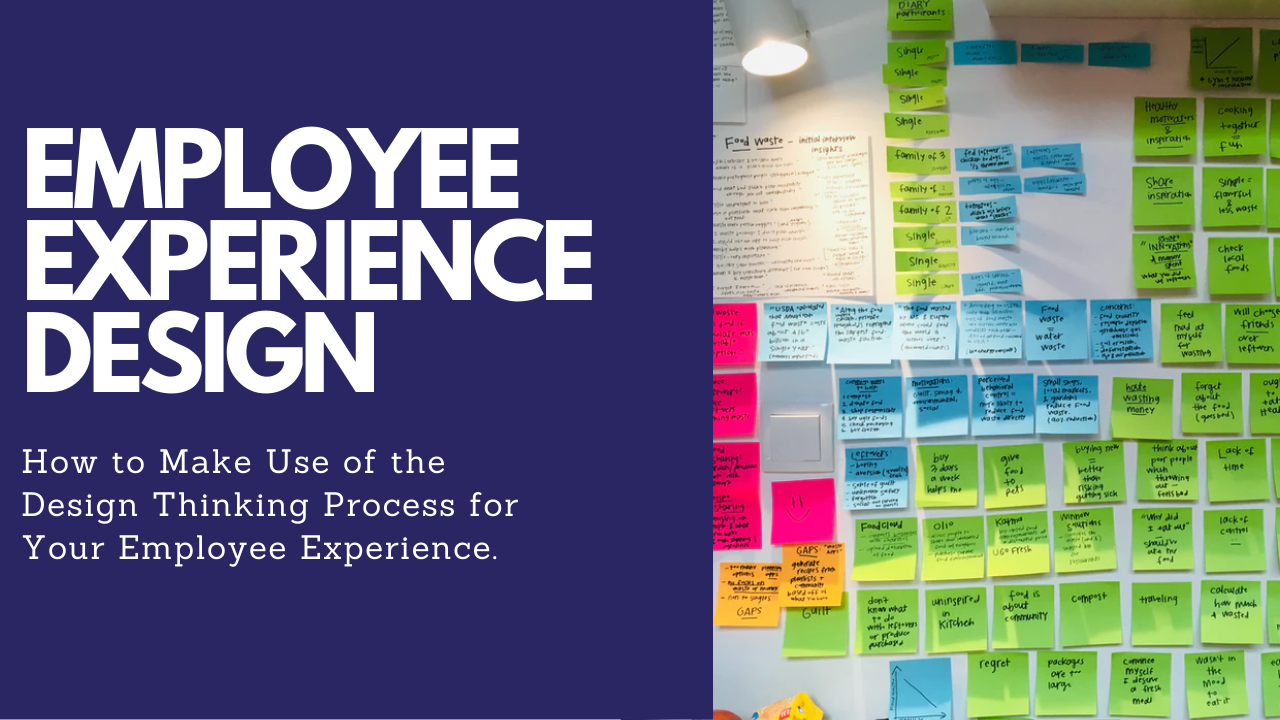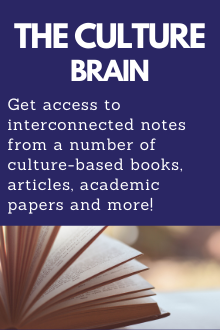How To Apply Design Thinking To The Employee Experience
The Design Of Your Employee Experience Can Make Or Break Your Organization.
Design thinking and employee experience design is something organizations like to discuss, but struggle to understand.
It’s like the organizations who think they can say they’re agile by getting a few people to do sprints.
What This Guide Will Cover On Employee Experience Design:
(click on the links below to jump to that section)
- What Is Design Thinking?
- What Are The Benefits Of Using Design Thinking?
- How To Use The Design Thinking For Your Employee Experience Design.
- What Are Examples Of Organizations Successfully Using Design Thinking For The Employee Experience
- Challenges of Design Thinking
- Conclusion And Next Steps
1. What Is Design Thinking?
You will get many different answers for what the design thinking process is.
A lot of organizations like to say that they use the design thinking process. While that might be true, many CEOs or misguided executives read a blog post (such as this one?) or a book on design thinking. They want to integrate it, but didn’t understand the whys behind design thinking.
You get people touting “the future of work” because other organizations are doing so, so you need to as well (for further reading, see my thoughts on the future of work here).
In a way, it’s like Michael Scott declaring bankruptcy. You can’t just yell out that you’re bankrupt.
What does Ideo have to say about design thinking?
They are one of the organizations most associated with the design thinking process.
From Ideo U, What is Design Thinking?
They have a book that I would recommend:
The Field Guide to Human-Centered Design
*Note that the above is an affiliate link*
To note, I am always amused by the use of the word “human-centered”, but I get it. For a long time, it seems like most organizations don’t see users as humans. Especially developers.
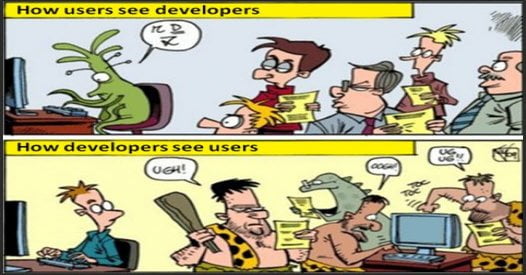
It’s all love developers. You know I jest…maybe. Image source: Reddit
What does Interaction Design Foundation have to say about design thinking?
Coming from their post on What is Design Thinking and Why Is It So Popular?
Ok, it’s becoming more clear. I like how they break down both the problem, and the solution.
The design thinking process varies depending on who you talk to when it comes to details, but the main foundation tends to be agreed upon.
I mentioned earlier when someone asked me what I feel design thinking means to me, I had a hard time defining what it was. There was a talk I attended where the speaker said the following:
This quote as stuck with me, and I feel to me, it’s part of what I use when it comes to defining design thinking.
While design thinking does also focus on the solution, it’s the problem that people need to spend the most time on.
It’s easy for teams and organizations to get swept up in what they’re going to build, what framework they’ll use, but not focus on the problem that they’re trying to solve.
-Donald A. Norman, The Design of Everyday Things
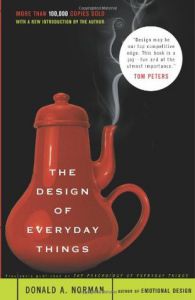
*Note that the above books is one of our recommended books to read on Corporate Culture – Check out the list here.*
2. What Are The Benefits Of Using Design Thinking?
If used the right way, here are ways that design thinking can help:
- It reduces the risk associated with launching new ideas. As design thinking helps you come up with several solutions, you won’t be as married to your possible solutions.
- It helps capture the mindsets and needs of the people (or humans, if you want to use that word) you’re creating for.
- It paints a picture of the opportunities based on the needs of these people (or humans).
Let’s take a look at some stats:
- Over the past ten years, design-driven organizations have outperformed the S and P 500 Index by 228%. This includes organizations like Apple, Coca-Cola, Ford, and Nike.
- 71% of organizations that practice design thinking report it has improved their working culture on a team level.
- Projects are 2x faster to market, 75% reduced design time, and 33% reduced development time.
Invest in organizations that use the design thinking process! The ones that actually do, instead of talking about it. You’ll be rich!
There are many organizations who use the design thinking for their customer problems, but never for their own employees. Why not? It’s not like you have to reinvent the wheel with it. The concepts applied here work to create a solid employee experience framework.
Before going forward, I want to be clear – using design thinking for your employee experience is NOT a be-all, end all of solving all your problems.
That said, if used properly, it will do wonders for your organization on so many fronts. Used properly, you’ll find that your retention rates will rise, and turnover will drop, which we are a big advocate of for your organization.
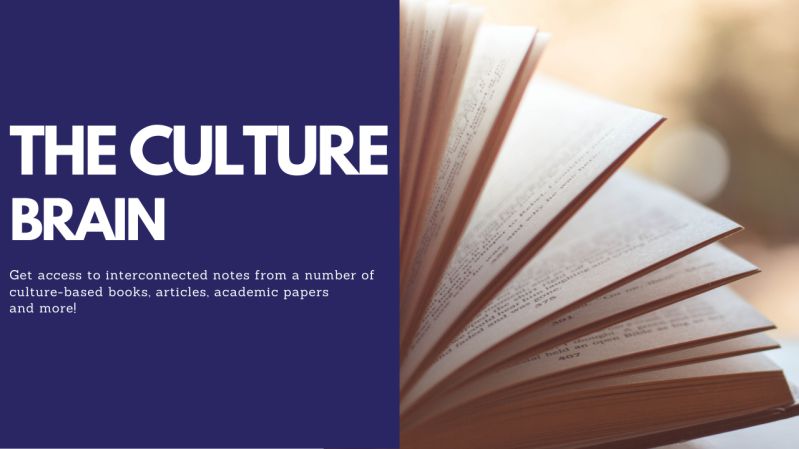
3. How To Use The Design Thinking Process For The Employee Experience.
Let’s get into the thick of things and the main point of this post:
How might we improve the employee experience design at our organization?
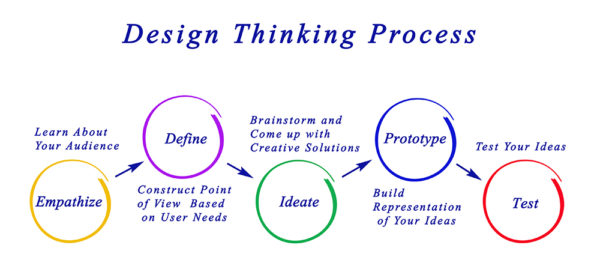
1. Empathize – Learn who your audience is.
This step, along with defining the problem, should be where you spend the most amount of your time.
These are the steps where you’ll gain the most insight into pain points, and opportunities for improvement,.
Lots of people skip this step because “they understand their customers” or “they understand their employees”. Don’t be one of those people. It’s super easy to become out of touch. Remember, when you assume, you make an ASS out of U and ME.
How do you go about this?
Simple answer is you go talk and observe employees. Heck, you’re an employee! You have your own experiences and insights. Interview others and get them to interview you to pull out all those gushy pain points that lie below the surface.
The five whys game is a fantastic way of pulling out user pain points that lie below the surface.
As well, get out of your office and department as well. Don’t keep this siloed. Pull from other areas, and other offices if you have them.
While you will gain plenty of insight if you interview and observe within HR, you do need to look elsewhere. You don’t want it to be a case of “it’s them, not us”. Don’t be like Principal Skinner.
2. Defining The Problem.
Having done the first step, you can get into defining the problems for your employee experience.
This is where you start coming up with questions to help you come up with ideas for your solutions.
For example, here’s one that you can use for the onboarding process:
- How might we improve our onboarding process so new employees don’t feel like George Costanza being handed the Penske file?
I did write about this in my post about the onboarding process, and here’s more context for the Penske file.
Here are some more examples for possible questions that might arise if focusing on the onboarding process:
- How might we improve our onboarding process for remote workers?
- How might we extend our onboarding process beyond just a week?
- How might we identify what new employees are looking to get out of the onboarding process?
If you’re looking for some employee onboarding ideas for inspiration, check out this post that we’ve written:
Ten Employee Onboarding Ideas Your Organization Can Use Right Now
If you’re finding a lot of pain points in the recruiting process:
- How might we better filter through potential candidates?
- How might we differentiate ourselves from others in the recruitment process?
Again, these are just some ones off the top of my head, and since every organization has its own sets of quirks, you can come up with very different questions and problems to be solving.
I want to emphasize again how important these first two steps are in regards to defining the problem.
― Donald A. Norman, The Design of Everyday Things
You need to have a solid foundation and understanding of the problem before you get into the details of the solution.
Organizations love to rush through theses steps and instead focus on the solution.
3. Ideate For Employee Experience Design.
Now we can get to the step that so many love to rush into.
It’s up to you and your team to come up with possible solutions to the problems that you have identified.
Now you can pull out the sticky notes, and the sheets of paper, and get thinking!
How do you come up with possible solutions?
-Leonard Cohen
There’s a million and one possibilities here to coming up with solutions. Interaction Design as a good guide to get started with coming up with ideas – What is Ideation?
I’m not delving too deep into this aspect as:
- There are plenty of great resources on coming up with solutions (like the link above)
- I again want to emphasize how important the first two steps are in addressing the problem.
4. Prototype.
Time to fire up balsamiq or sketch, or sharpies, or even dump lego in front of the team.
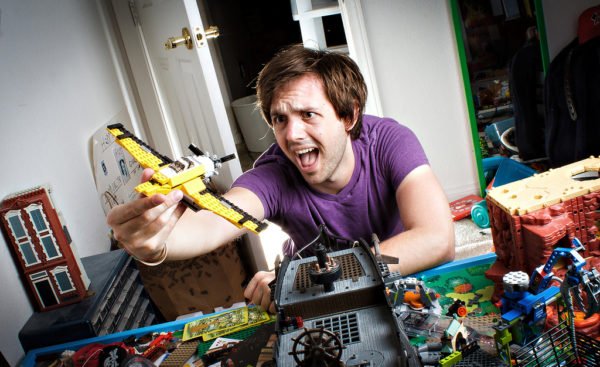
I know it’s tempting, but building lego planes isn’t the task at hand. Source – Phys.org
You’re not looking to build out an app or whatever you come up with 100% to spec. Get something that gets the point across. The next step is far more important and will give insight into what you have built as a solution.
To be clear as well, you’re not looking for one perfect solution here.
Come up with several solutions. Looking at Cisco’s hackathon, they had numerous several solutions to the problems they defined.
The value of multiple solutions:
Ideo did a study on organizations who made use of the design thinking process for solving problems and building products. The findings?
“…when teams iterate on five or more different solutions, they are 50% more likely to launch a product successfully.”
Ideo Studied Innovation In 100+ Companies–Here’s What It Found
So don’t fall in love with that one solution that you have. Try out multiple ones.
5. Test Your Solutions For You Employee Experience Design.
Now you put your solution to the test. How does it hold up? Were you right on the mark? Were you way off-target? Did things come up in testing that you didn’t even think about, or you missed during the empathize and defining stage? Do you need to redefine the problem?
How much testing should I do?
This is a common question that I get on this front. Should I be getting feedback from one person? Three people? 132 people? What’s the best choice on this front?
Usually, all you will need is five users to test out your idea.
Why five?
When you test the second user, you will discover that this person does some of the same things as the first user, so there is some overlap in what you learn. People are definitely different, so there will also be something new that the second user does that you did not observe with the first user. So the second user adds some amount of new insight, but not nearly as much as the first user did.
The third user will do many things that you already observed with the first user or with the second user and even some things that you have already seen twice. Plus, of course, the third user will generate a small amount of new data, even if not as much as the first and the second user did.
As you add more and more users, you learn less and less because you will keep seeing the same things again and again. There is no real need to keep observing the same thing multiple times, and you will be very motivated to go back to the drawing board and redesign the site to eliminate the usability problems.
If you start seeing the same patterns over again about what works, and what doesn’t, then five should be more than enough.
I’m going to post the image again of the five step process, but this one gives a bit more detail:
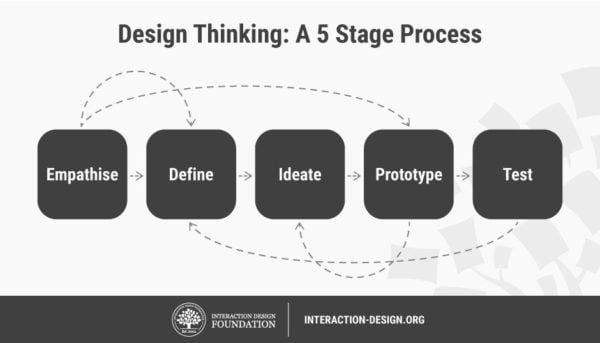
Source – Interaction Design Foundation
Notice the arrows.
Notice how after testing, you go back to the define stage. As I mentioned, there are insights that you now have once you put a possible solution in front of people.
I also like to note the empathize to prototype jump. Plenty of organizations like to jump right to prototype with one possible solution.
4. What Are Examples Of Organizations Successfully Using Design Thinking In HR?
While researching for this guide, I came across a great example on the Cisco Employee Experience, and how they made use of the design thinking process to improve their own employee experience design.
Cisco HR Breakathon: Reimagining The Employee Experience
I’m going to take excerpts from the article and comment on it.
I love how serious the Cisco employee experience was for the organization. To shut down the HR for 24 hours to work on the employee experience design shows that leadership put great value on working on it.
Continuing on…
Instead of identifying one big problem to address, the Breakathon provided guidance on how to identify a problem as a way to empower participants to come up with what is getting in the way of creating a truly engaging employee experience.
Identifying the problem is such a key aspect of design thinking.
Who gives a hoot about your solution if you don’t understand the problem, or care about it? You might as well go try and talk to a duck. The employee experience design you come up with won’t matter.
Talk about several solutions! You’re going to create a much better employee experience framework if you’re not married to one solution.
So, if Cisco, an organization that I’m guessing is larger than yours, can shut down HR for a day to use the design thinking process to improve the Cisco employee experience, why can’t you?
Looking at other organizations, here’s an excellent article from HBR-
THE NEW RULES OF TALENT MANAGEMENT
I will be pulling from various sections of this article. While this article focuses more on the solutions various organizations used as opposed to the problem, it is helpful to look at.
Matt Hoffman, its vice president of people, says it focuses on creating a culture that inspires purpose and creativity.
This is an interesting solution to help with the employee experience design. Note that there is also a technical career track for the more developer-minded individuals, so it’s not just a one-size-fits-all approach.
So the company has invested heavily in training supervisors on topics such as how to establish employees’ priorities and goals, how to provide feedback about contributions, and how to align employees’ career aspirations with business needs and learning and development plans.
The article also has a bit about our friends from Cisco and their focus on the Cisco employee experience:
It’s a bit disappointing that the article (and others I found) focused more on the solutions instead of the problem. That said, it does show how several solutions generated can help with the overall employee experience.
Here is a case of Southwest Airlines redesigning their uniforms that was design-driven:
Now arriving: Southwest Airlines debuts it first uniform redesign in 20 years
After initial design, the uniforms were field-tested over the course of six months by 120 employees who helped refine the final product.
“We had a red dress all the girls thought would be dynamite, but when we put it out, the functionality had a bit too much flair. It was not as forgiving,” she said. “But the beauty of that is we let our employees go through the process for themselves.”
5. Challenges of Design Thinking:
As design thinking CAN be, we have to make mention of the shortcomings. It’s not a silver bullet that works in every situation.
From The Total Economic Impact™ Of IBM’s Design Thinking Practice
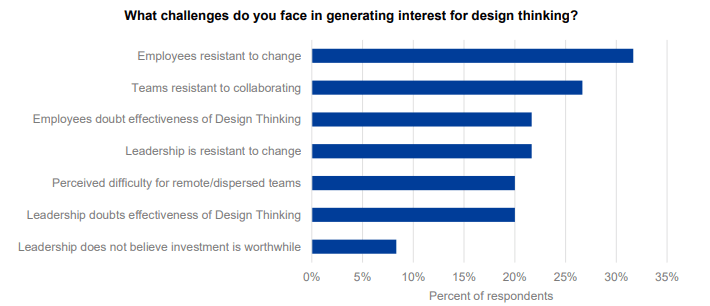
What can you do about this?
Well, from another study on the impact of design thinking in organizations – Design Thinking Study: Parts Without A Whole?

So there is a possibility that design thinking exists in some shape or form at your organization. Where is it most common?
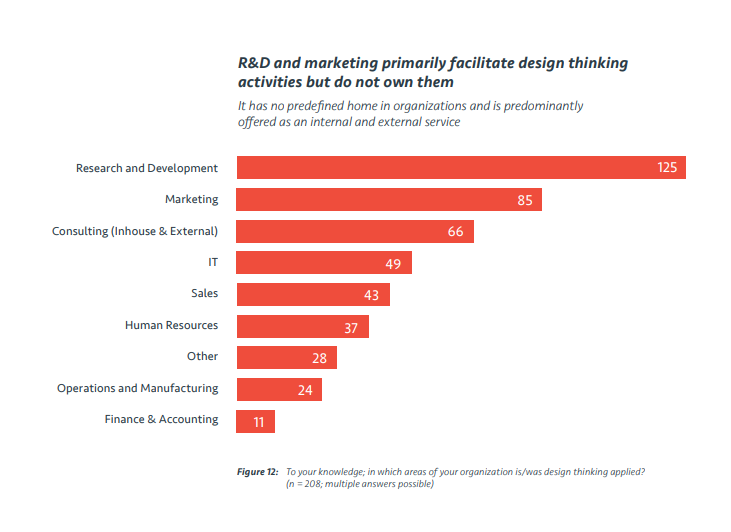
So if your organization has a UX area, or marketing, take a stroll over (or zoom call) and see if they make use of design thinking. Having a champion that already exists can make buy-in that much easier.
Another major issue with design thinking comes from measuring its impact and the ROI. From the paper above:
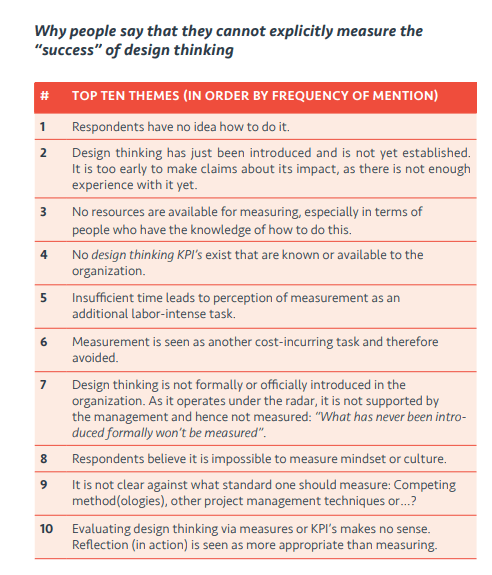
So what can we do about this?
Intuit, a design-driven company, addressed the issue in the following – Intuit: From Stories and Metrics
Opportunistic in terms of attentively listening to what the company cares about, or as Wendy put it: “I don’t think there is any particular metric. If your company merely cares about commercial innovation to increase attraction on some marketing webpages that’s your metric to begin with.” This however, she also added, requires that you help them reframing the metrics alongside the design challenge at hand.
They knew that during design thinking processes, repeatedly initial innovation intents change anyhow, so that metrics, which really matter, will emerge. Karen adds: “Often people want a measure from you that you can’t provide them with. But you can give them something else.” In her opinion it is important to give teams those useful surrogates that you are able to provide and explain why they are more meaningful.
Intuits approach is surprisingly simple, yet effective. Whereas most people (besides management and finance) don’t get very »emotional« about plain numbers, basically everyone in the organization enjoys a lived culture of company-wide appreciation and celebration of success and smart failures. People are naturally interested in other people. And it is humans who move metrics. This is why Wendy Castleman compiles a yearly »Innovation Catalysts Book« which showcases all the major success stories which had a significant financial impact. “Stories need metrics” she says “and we look at all the usual ones the company cares about: revenue, cost, profit, employee and customer engagement. But when you’re trying to pair it with design thinking it is important to show how you got here. Basically all stories are about that!”
Taking a story based approach, and then integrating metrics worked best for Intuit. The whole article is worth reading, so please check out the link above for more insight and examples from Intuit.
As well, check out my post on Employee Journey Mapping.
6. Conclusion And Next Steps:
We reviewed the following (click the links below to jump back to that section).
- What Is Design Thinking?
- What Are The Benefits Of Using Design Thinking?
- How To Use The Design Thinking Process For Employee Experience Design.
- What Are Examples Of Organizations Successfully Using Design Thinking For The Employee Experience?
- Challenges of Design Thinking
Before you fire up that organization HR hackathon or brainstorming session, I want to mention the design thinking process is an ongoing process.
Improving the employee experience design is not going to happen overnight.
If you take the time to understand the pain points and problems to tackle, I have the utmost confidence you will come up with solutions that you can use to improve the employee experience.
What You Can Do Now To Make Use Of Design Thinking In HR:
Start talking to employees, and finding out the things that they struggle with in regards to the employee experience. Whether that’s asking yourself, your close co-workers, your boss, employees from other departments, becoming aware of these experiences of others and digging below the surface will allow you to create a better employee experience design.
Books To Read On Design Thinking:

- Change by Design: How Design Thinking Transforms Organizations and Inspires Innovation
- The Design of Everyday Things
*Note that the above is an affiliate link*
We at Playficient can help you out with your employee experience design by using design thinking in HR.
It’s one of our core offerings! We can come in to help you identify the shortcomings in your employee experience design, and how to use the design thinking process to improve it. It’s a long-term investment that pays dividends should you focus on it.
Feel free to contact us if you have any questions.

